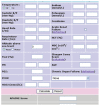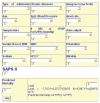Prognostic categorization of intensive care septic patients
- PMID: 24701404
- PMCID: PMC3953866
- DOI: 10.5492/wjccm.v1.i3.67
Prognostic categorization of intensive care septic patients
Abstract
Sepsis is one of the leading worldwide causes of morbidity and mortality in critically-ill patients. Prediction of outcome in patients with sepsis requires repeated clinical interpretation of the patients' conditions, clinical assessment of tissue hypoxia and the use of severity scoring systems, because the prognostic categorization accuracy of severity scoring indices alone, is relatively poor. Generally, such categorization depends on the severity of the septic state, ranging from systemic inflammatory response to septic shock. Now, there is no gold standard for the clinical assessment of tissue hypoxia which can be achieved by both global and regional oxygen extractabilities, added to prognostic pro-inflammatory mediators. Because the technology used to identify the genetic make-up of the human being is rapidly advancing, the structure of 30 000 genes which make-up the human DNA bank is now known. This would allow easy prognostic categorization of critically-ill patients including those suffering from sepsis. The present review spots lights on the main severity scoring systems used for outcome prediction in septic patients. For morbidity prediction, it discusses the Multiple Organ Dysfunction score, the sequential organ failure assessment score, and the logistic organ dysfunction score. For mortality/survival prediction, it discusses the Acute Physiology and Chronic Health Evaluation scores, the Therapeutic Intervention Scoring System, the Simplified acute physiology score and the Mortality Probability Models. An ideal severity scoring system for prognostic categorization of patients with systemic sepsis is far from being reached. Scoring systems should be used with repeated clinical interpretation of the patients' conditions, and the assessment of tissue hypoxia in order to attain satisfactory discriminative performance and calibration power.
Keywords: Genome; Prognostic markers; Sepsis; Severity scoring systems; Systemic inflammatory Response syndrome.
Figures





Similar articles
-
Sepsis mortality prediction with the Quotient Basis Kernel.Artif Intell Med. 2014 May;61(1):45-52. doi: 10.1016/j.artmed.2014.03.004. Epub 2014 Mar 27. Artif Intell Med. 2014. PMID: 24726036
-
Multiple Organ Dysfunction Score Is Superior to the Obstetric-Specific Sepsis in Obstetrics Score in Predicting Mortality in Septic Obstetric Patients.Crit Care Med. 2017 Jan;45(1):e49-e57. doi: 10.1097/CCM.0000000000002018. Crit Care Med. 2017. PMID: 27618276 Free PMC article.
-
Mid-regional pro-adrenomedullin as a prognostic marker in sepsis: an observational study.Crit Care. 2005;9(6):R816-24. doi: 10.1186/cc3885. Epub 2005 Nov 15. Crit Care. 2005. PMID: 16356231 Free PMC article.
-
Scoring systems for outcome prediction in patients with perforated peptic ulcer.Scand J Trauma Resusc Emerg Med. 2013 Apr 10;21:25. doi: 10.1186/1757-7241-21-25. Scand J Trauma Resusc Emerg Med. 2013. PMID: 23574922 Free PMC article. Review.
-
An overview of mortality risk prediction in sepsis.Crit Care Med. 1995 Feb;23(2):376-93. doi: 10.1097/00003246-199502000-00026. Crit Care Med. 1995. PMID: 7867363 Review.
Cited by
-
The Effect of Mesenchymal Stromal Cells on the Mortality of Patients with Sepsis and Septic Shock: A Promising Therapy.Emerg Med Int. 2022 Jun 24;2022:9222379. doi: 10.1155/2022/9222379. eCollection 2022. Emerg Med Int. 2022. PMID: 35784641 Free PMC article.
-
Blood lactate concentration after exposure to conducted energy weapons (including TASER® devices): is it clinically relevant?Forensic Sci Med Pathol. 2013 Sep;9(3):386-94. doi: 10.1007/s12024-013-9436-4. Epub 2013 Apr 19. Forensic Sci Med Pathol. 2013. PMID: 23605975 Review.
-
Pancreatic injury in patients with septic shock: A literature review.World J Gastrointest Oncol. 2016 Jul 15;8(7):526-31. doi: 10.4251/wjgo.v8.i7.526. World J Gastrointest Oncol. 2016. PMID: 27559431 Free PMC article. Review.
-
Increased plasma vaspin concentration in patients with sepsis: an exploratory examination.Biochem Med (Zagreb). 2015;25(1):90-6. doi: 10.11613/BM.2015.011. Biochem Med (Zagreb). 2015. PMID: 25672472 Free PMC article. Clinical Trial.
References
-
- Bone RC, Balk RA, Cerra FB, Dellinger RP, Fein AM, Knaus WA, Schein RM, Sibbald WJ. Definitions for sepsis and organ failure and guidelines for the use of innovative therapies in sepsis. The ACCP/SCCM Consensus Conference Committee. American College of Chest Physicians/Society of Critical Care Medicine. Chest. 1992;101:1644–1655. - PubMed
-
- Rangel-Frausto MS, Pittet D, Costigan M, Hwang T, Davis CS, Wenzel RP. The natural history of the systemic inflammatory response syndrome (SIRS). A prospective study. JAMA. 1995;273:117–123. - PubMed
-
- Le Gall JR, Lemeshow S, Leleu G, Klar J, Huillard J, Rué M, Teres D, Artigas A. Customized probability models for early severe sepsis in adult intensive care patients. Intensive Care Unit Scoring Group. JAMA. 1995;273:644–650. - PubMed
-
- Marshall JC, Cook DJ, Christou NV, Bernard GR, Sprung CL, Sibbald WJ. Multiple organ dysfunction score: a reliable descriptor of a complex clinical outcome. Crit Care Med. 1995;23:1638–1652. - PubMed
-
- Webster NR. Activated protein C in sepsis. AJAIC. 2001;4(Suppl 1):41–42.
Publication types
LinkOut - more resources
Full Text Sources

